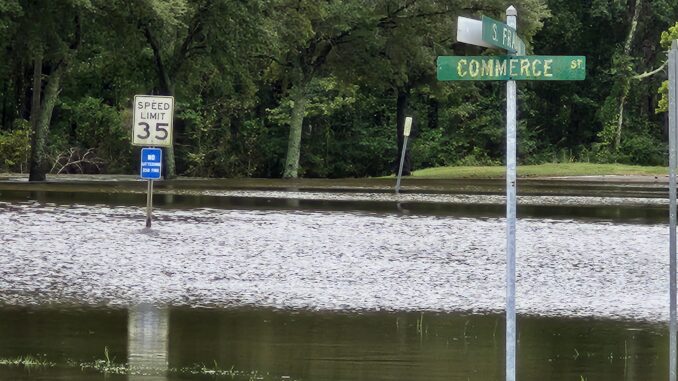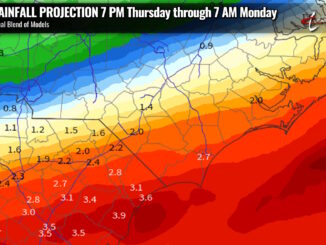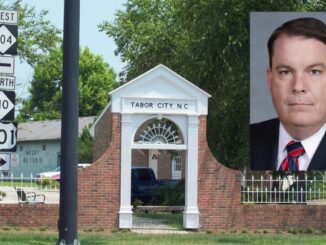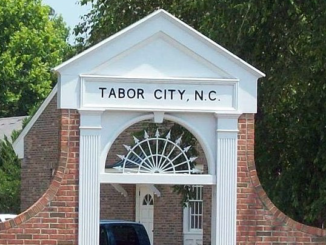
Sunday’s double-punch of heavy rain didn’t catch Whiteville Public Works unaware, but there was little that could be done when an additional foot of runoff came downstream from heavy rains that fell west of the city.
“Our stormwater crew is out there every day,” City Manager Darren Currie said. “Since we established the crew, they try to hit three different jobs a day to stay ahead as much as we can.”
When the National Weather Service warned that Columbus County could see heavy rains over the weekend, Currie said the stormwater crew and other public works teams went into high gear clearing drains, checking and if necessary cleaning ditches, and getting ready.
As such, Currie said, the city’s stormwater system “did a good job this time.
“This was about the equivalent of a 25 year storm,” Currie said. “I have said many times that our systems are usually designed for a 10-to-25 year storm. Roughly eight inches of rain fell in Whiteville, which is about what our current system is designed to handle in two days’ time.”
While eight inches of rain fell on Whiteville Sunday, more than a foot fell in some places in Chadbourn. That town saw flooding similar to Hurricane Florence in 2018, but since Chadbourn has aggressively pursued stormwater infrastructure repair in recent years, the water quickly ran off downstream.
Tributaries to Soules Swamp catch the outflow from Chadbourn, bringing it down the main run of Soules Swamp under the single bridge on Madison Street in downtown Whiteville. Due to extensive infilling of the swamp in the downtown area, the water can and often does back up when it meets the chokepoint on Madison Street. Combined with a lack of maintenance to the old railroad bed between Chadbourn and Whiteville, and the need for repairs on Mollies Branch, stormwater from upstream cannot spread out, and has nowhere to go but straight ahead onto the land that was once part of the swamp.
“Approximately 9:30 p.m. Sunday,” Currie said, “I left the fire department and went home. Streets were clear downtown. Yes, there were some areas that had minor flooding, however, we were in great shape.”
Franklin Street, for example, had around a foot of water covering several intersections at 7 p.m. Sunday, but an hour later, only a few puddles remained. Water was still high in perennial trouble spots along Lee, Main and College streets, but most of the water was gone within a few hours.
The stormwater system handled everything that fell on Whiteville, Currie said, but that water was still in Soules Swamp heading for the Waccamaw River when the second wave of runoff moved in during the overnight hours.
“Monday morning,” Currie said, “when I got out of bed at 5:30 a.m., I had texts from Hal Lowder (City emergency Services Director) notifying me that downtown was beginning to flood.”
Stormwater pipes empty into the swamp, Currie explained. When the swamp rose, runoff slowed while the first of the water headed downstream. That caused storm sewer pipes to back up, slowing the runoff that was coming downstream from Chadbourn that had to follow the same route into the swamp.
“It all works together,” Currie said, “and it all flows downstream, through Whiteville. When there’s no room left in the swamp as we know it, it spreads out into where the swamp was before.”
In the mid-20th century, sections of the swamp near downtown were used as an impromptu city dump. Aerial photography shows “dry” land increasing over the course of about 40 years from roughly today’s intersection of Franklin, Lee and Madison all the way to Caldis and Frazier streets.
Everything from household garbage to building materials and recovered pavement and cement were dumped, creating new land that was in turn developed with businesses. In some cases, entire houses were demolished and dumped into low areas, which were then covered in fill dirt and eventually, pavement. During a dry spell in the early 2000s, the late historian Robb Cross noted finding rusted cans, rebar, pieces of sewing machines, and even antique farm implements and industrial equipment in a washout a few dozen yards from the Madison Street Bridge.
At the same time the swamp was being filled, Currie said, the city was growing, and more streets were paved.
“It’s hard for some folks to believe but fifty years ago dirt streets were not that uncommon, even in a city like Whiteville.”
Hard surface parking lots and roofed buildings eliminated the dirt and grass surfaces that had once absorbed rainwater.
“It’s amazing to think of it now,” Currie said, “but the old maps and photos show farmland in the area of what is now Columbus Regional, heading all the way to White Marsh.”
The undeveloped land was ditched and managed by farmers, Currie explained, further helping remove excess water.
“With progress comes paving,” he said. “We are paying the price for what was done by some of those who came before us, but attitudes were different then.”
When an unusually strong summer storm flooded downtown Whiteville in 2016 – followed within weeks by Hurricane Matthew – city council instructed staff to begin aggressively pursuing solutions to downtown flooding. While the downtown area is the most prominent area that floods, Currie explained that the water filling downtown is flowing from neighborhoods and streets outside the retail district.
City staff applied for ad received a $150,000 grant to study the flooding problem in the wake of Hurricane Matthew. That study was actually underway when Florence brought even more water to the city.
The study identified multiple weak spots in the city’s stormwater system, and one by one, Currie said the city has been tackling those projects as funding comes available.
A $400,000 grant from the Golden LEAF Foundation helped make improvements on Todd Alley and Lee Street. The city funded improvements along Commerce and Caldis streets for $295,000. Officials have obtained $1.3 million for improvements along Canal Street, where the railroad bed acts as a dam, affecting drainage as far west as Jefferson Street. Other projects include Walter Street ($249,000) the South Canal Outfall ($870,000) Phase Three of West Walter ($194,000) South lee ($243,705) and East Virgil/East Columbus ($343,000).
The city has also improved some drains along the sides of College Street, and opened a drainage ditch through McKenzie Woods to improve stormwater flow to White Marsh. That project alone cost $95,000. The city is applying for grant funding and working with homeowners to obtain necessary easements to install improvements there. After the engineering work has been completed for that project, Currie said, the city will have a better idea of the final cost for the entire work area.
A multimillion dollar BRIC grant from the Federal Emergency Management Administration (FEMA) was being combined with other funding to improve Mollies Branch and the outflow from that system, but the funds were clawed back by the federal government due to budget cuts. The city still has $1.7 million from the state Division of Emergency Management toward that project, which helped pay for the sweeping study by NCSU Coastal Dynamics and Design Lab. The Lab helped the city apply for and obtain the federal and state funding for Mollies Branch, and officials are now considering other ways to fund the project.
The city has been widely criticized over the new Madison Street Park, Phase One of which has a $1.3 million price tag. Currie pointed out that the funding for the park did not come out of the city coffers, but was through a parks grant and private donations.
“That money was granted with a very specific purpose,” he said. “We couldn’t just use it for anything we wanted.”
The park is located on what was once the Lewis Smith Shopping Center – the county’s first modern shopping plaza, and a focal point for flooding in recent years. The center’s acres of rooftops and paved parking prevented stormwater absorption in an area that had once been swampland. The iconic Gurganous Feed Mill and the shopping center were both heavily damaged in Florence and Matthew, with several feet of water standing inside each building for days.
The shopping center was eventually condemned after being inundated twice. A catastrophic fire damaged what was left of the 50,000 square foot structure in 2022. The land and building were eventually donated to the city which demolished the building, stripped up most of the paving and improved drainage leading into the swamp.
The Madison Street Park will eventually feature permeable-surface walking paths, a pond that will also help control the rate of stormwater flow, thus relieving some pressure on the swamp, and open areas and infrastructure designed to be flood-resistant.
“That property couldn’t easily be redeveloped,” Currie said, “because it is a major part of the floodplain. By having a useful feature there, we have an amenity that will attract more people downtown, and we have somewhere for the floodwater to go when it rains. It’s a win-win situation.”
Currie explained that grants and loans for specific projects cannot be switched back and forth between accounts. State law and funding agencies require funds obtained for stormwater, street work, sidewalks, parks or sewer be used for the reasons they were requested.
“If an auditor came in and discovered the city manager or finance officer had been using funds from, say, a street improvement loan for stormwater – we could face felony charges.”
As an example, he noted the Mollies Branch Sewer Improvement Project. The State Revolving Fund Loan for $4.6 millions specifically says 6,425 lineal feet of sewer main, 30 manholes, 25 service laterals, and sidewalk, roadway and driveway repair, along with abandoning the old sewer system.
“If we discovered that we need 6,430 feet of sewer line,” Currie said, “We would have to be prepared to document why. The same goes for any project like that. Money can’t just be moved over where we want to move it.”
The city also has to deal with permits to do some projects, unlike private citizens. The citizens who contracted a specialist to blow beaver dams last fall, he said, made a big impact in terms of the amount of water that affected downtown.
“The beavers and the beaver dams are just part of the problem,” he said. “We participate in the county’s beaver bounty program, but when it comes to removing dams we have to jump through extra hoops to move equipment across private property. Then there’s liability issues as well. A private citizen making a deal with another private citizen doesn’t have to meet the same requirements that we do as a local government.”
Currie said the city will never be totally free from flooding, “but rest assured, the staff and council are doing their best.
“We are in a low spot, and some parts are built on a swamp,” he said. “That’s not a quick fix, or a cheap one.
“It would take millions of dollars, and a major jump in the tax rate, to fix everything at once,” he said. “We can’t fix decades of impacts overnight, but we are working on it. Council said they want the stormwater improved, and staff is doing just that.”
Even when the money is available, Currie said, the city needs studies to prove the needs for the funding, environmental impact studies, and plans to deal with the problems.
“It’s a slow process,” he said. “I know it’s frustrating. We want to do right by our citizens.”


























